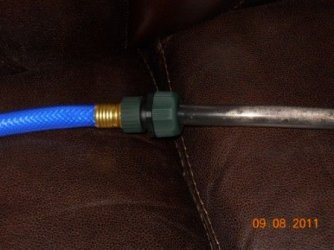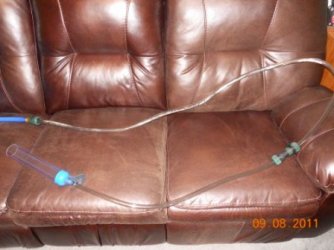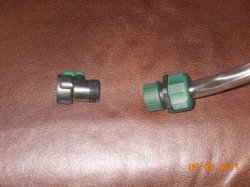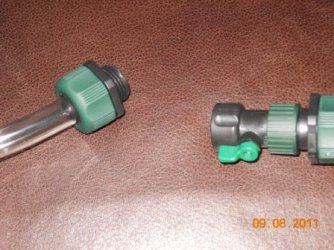BIGbadJOHN
Fish Fanatic
I posted a question on what type of water hose to use when putting together your own Python type water changer and got some requests to show everyone how to do it, so here it is.....
This is my version, closest I believe to what you can make to the actual Python type water changer. In my experience I actually didn't save any money as compared to if I were to have bought the WalMart brand "python" which costs about $33 here. You'll definitely come out way ahead if you compare it to an actual Python. My increase in cost was mainly due to having to buy a gravel vacuum since I didn't have the size needed and also having to buy a couple extra adapters for my faucet since it's a smaller fitting than normal faucets. I bought everything at WalMart except for the gravel vacuum.
My costs included:
1-Waterbed drain & fill kit (found online) $7 x 1
1-Water supply hose (Apex RV/Camper 5/8" Hose) $10 x 1
1-Garden hose inline shutoff valve $1.50 x 1
2-Female garden hose splice ends $2.00 x 2
1-Male garden hose splice end $2.00 x 1
1-Gravel vacuum (Large Aqueon) $13.00 x 1
2-Faucet adapters $5.00 x 2
So as you can see, in all I spent $42.50. However, I don't think the gravel vacuum or at least one of my faucet adapters count since I needed to buy a larger gravel vacuum anyways and a lot of people won't have an oddball faucet like I do and will only need to buy 1 adapter or maybe none since the waterbed fill kit comes with one to fit most standard faucets. That would bring the total down to around $24.50. So you are saving around $10 if compared to a Lee's brand faucet gravel vacuum or an AquaCulture brand. The savings aren't HUGE unless compared to the actual Python. I would also like to add that the gravel vac I bought had 2 sections of clear tube and I chose to use both, thus making it look more like an actual Python with the shut off a little ways back off the gravel vac. By all means, don't cut your clear tube on your gravel vac just to make it look like mine. It's unnecessary and you'll actually save the cost of one splice end.
Also I've seen several sites on the internet stating not to use a regular garden hose with this set up because of the chemicals used on the insides of the hoses. I don't think a normal garden hose would be a problem though because, if you think about it, the first thing you'll be doing is sucking water out of your tank. So the water running through the hose from the tank will flush all the residual chemicals down the drain before you add water back in. Plus, I don't think hoses leach too much of that stuff unless they've been sitting out in the sun like they do in the yard. If you want to play it safe, get a drinking water or RV hose like I did. You could even get the all clear hose, but you may as well just buy a python if your going to do that.
So here are the pictures of the finished product:
This is the first hookup you must make coming from the garden hose end. It's one of the female garden hose splice ends. It links the garden hose to the clear tube of the gravel vac.
This is my version, closest I believe to what you can make to the actual Python type water changer. In my experience I actually didn't save any money as compared to if I were to have bought the WalMart brand "python" which costs about $33 here. You'll definitely come out way ahead if you compare it to an actual Python. My increase in cost was mainly due to having to buy a gravel vacuum since I didn't have the size needed and also having to buy a couple extra adapters for my faucet since it's a smaller fitting than normal faucets. I bought everything at WalMart except for the gravel vacuum.
My costs included:
1-Waterbed drain & fill kit (found online) $7 x 1
1-Water supply hose (Apex RV/Camper 5/8" Hose) $10 x 1
1-Garden hose inline shutoff valve $1.50 x 1
2-Female garden hose splice ends $2.00 x 2
1-Male garden hose splice end $2.00 x 1
1-Gravel vacuum (Large Aqueon) $13.00 x 1
2-Faucet adapters $5.00 x 2
So as you can see, in all I spent $42.50. However, I don't think the gravel vacuum or at least one of my faucet adapters count since I needed to buy a larger gravel vacuum anyways and a lot of people won't have an oddball faucet like I do and will only need to buy 1 adapter or maybe none since the waterbed fill kit comes with one to fit most standard faucets. That would bring the total down to around $24.50. So you are saving around $10 if compared to a Lee's brand faucet gravel vacuum or an AquaCulture brand. The savings aren't HUGE unless compared to the actual Python. I would also like to add that the gravel vac I bought had 2 sections of clear tube and I chose to use both, thus making it look more like an actual Python with the shut off a little ways back off the gravel vac. By all means, don't cut your clear tube on your gravel vac just to make it look like mine. It's unnecessary and you'll actually save the cost of one splice end.
Also I've seen several sites on the internet stating not to use a regular garden hose with this set up because of the chemicals used on the insides of the hoses. I don't think a normal garden hose would be a problem though because, if you think about it, the first thing you'll be doing is sucking water out of your tank. So the water running through the hose from the tank will flush all the residual chemicals down the drain before you add water back in. Plus, I don't think hoses leach too much of that stuff unless they've been sitting out in the sun like they do in the yard. If you want to play it safe, get a drinking water or RV hose like I did. You could even get the all clear hose, but you may as well just buy a python if your going to do that.
So here are the pictures of the finished product:
This is the first hookup you must make coming from the garden hose end. It's one of the female garden hose splice ends. It links the garden hose to the clear tube of the gravel vac.







